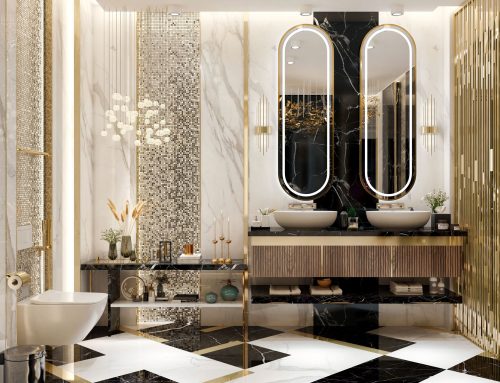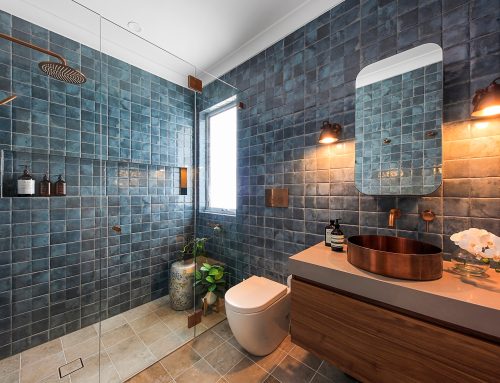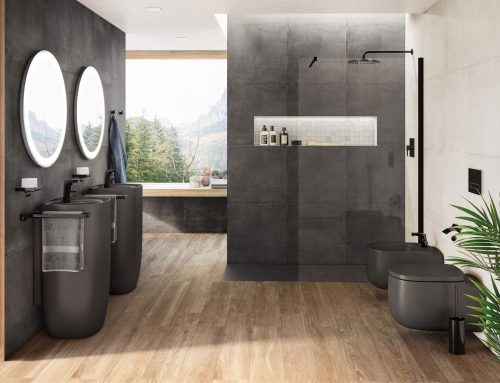Vintage and retro styles in bathroom design evoke a sense of nostalgia and timeless elegance. These designs are characterized by the use of classic fixtures, clawfoot tubs, and vintage tile patterns, creating an ambiance that transports you back to a bygone era. This article will explore the elements that define vintage and retro bathrooms, provide guidance on how to incorporate these elements into your design, and offer practical tips for achieving a cohesive and charming space.
Understanding Vintage and Retro Styles
Vintage and retro styles often overlap, but they each have distinct characteristics. Understanding these differences can help you create a bathroom design that captures the essence of your preferred era.
Vintage Style
Vintage style refers to designs inspired by a specific period, typically from the early to mid-20th century. This style is characterized by:
- Classic Fixtures: Vintage bathrooms often feature classic fixtures such as pedestal sinks, freestanding bathtubs, and traditional faucets.
- Ornate Details: Decorative elements like intricate moldings, wainscoting, and antique mirrors are common in vintage bathrooms.
- Rich Materials: Use of high-quality materials like marble, porcelain, and brass enhances the vintage aesthetic.
- Warm Color Palettes: Soft, warm colors such as cream, beige, and pastels create a welcoming and nostalgic atmosphere.
Retro Style
Retro style, on the other hand, typically draws inspiration from the mid-20th century, particularly the 1950s to 1970s. Key features include:
- Bold Patterns: Retro bathrooms often feature bold, geometric patterns in tiles and wallpapers.
- Vibrant Colors: Bright, vibrant colors like teal, mustard yellow, and avocado green are hallmarks of retro design.
- Funky Fixtures: Unusual shapes and designs in fixtures, such as rounded vanities and colorful sinks, are characteristic of retro bathrooms.
- Playful Elements: Retro style embraces a sense of fun and whimsy, with playful accessories and decor items.
Key Elements of Vintage and Retro Bathrooms
Creating a vintage or retro bathroom involves incorporating specific elements that define these styles. Here are the key components to consider:
Classic Fixtures
- Clawfoot Tubs: A quintessential feature of vintage bathrooms, clawfoot tubs add a touch of elegance and luxury. They come in various styles, including roll-top and slipper designs.
- Pedestal Sinks: These sinks are a staple of vintage design, offering a timeless and elegant look. Pair them with traditional faucets for an authentic feel.
- Freestanding Vanities: Opt for vanities with ornate details and antique finishes to enhance the vintage ambiance.
- Traditional Toilets: High-tank or pull-chain toilets add an authentic touch to a vintage bathroom.
Vintage Tile Patterns
- Subway Tiles: Classic white subway tiles are a hallmark of vintage bathrooms. They can be arranged in various patterns, such as herringbone or vertical stack, to add visual interest.
- Hexagon Tiles: Small hexagon tiles, often used in mosaic patterns, are another popular choice for vintage bathrooms. They are typically seen in black and white but can also be found in other colors.
- Penny Tiles: These small, round tiles are often used for flooring and create a charming, old-fashioned look.
- Checkerboard Patterns: Black and white checkerboard tiles are a retro classic, adding a bold and graphic element to the bathroom.
Color Palettes
- Soft Pastels: Colors like mint green, powder blue, and blush pink evoke a vintage feel and create a soothing atmosphere.
- Bold Retro Colors: Bright colors like turquoise, mustard yellow, and coral are perfect for creating a retro vibe.
- Neutral Tones: Warm neutrals like beige, ivory, and soft gray can be used to balance more vibrant colors and patterns.
Materials and Finishes
- Porcelain and Ceramic: These materials are commonly used for sinks, tubs, and tiles in vintage and retro bathrooms.
- Brass and Chrome: Traditional finishes like polished brass and chrome are ideal for faucets, showerheads, and hardware.
- Marble and Granite: These materials add a touch of luxury and sophistication to vintage bathrooms.
Decorative Elements
- Antique Mirrors: Mirrors with ornate frames or beveled edges enhance the vintage look.
- Vintage Lighting: Fixtures like sconces, chandeliers, and pendant lights with antique finishes add warmth and character.
- Decorative Hardware: Choose drawer pulls, towel racks, and hooks with vintage or retro designs to complete the look.
Incorporating Vintage and Retro Elements
Creating a cohesive vintage or retro bathroom involves carefully selecting and combining various elements. Here are some steps to help you achieve this:
Step 1: Define Your Vision
- Choose an Era: Decide whether you want a vintage bathroom inspired by the early 20th century or a retro bathroom with mid-century modern influences.
- Create a Mood Board: Gather inspiration from magazines, websites, and social media to create a visual representation of your desired style.
Step 2: Plan the Layout
- Consider the Space: Evaluate the size and layout of your bathroom to determine the best placement for fixtures and furniture.
- Prioritize Key Features: Identify the key elements you want to include, such as a clawfoot tub or a vintage vanity, and plan the layout around these features.
Step 3: Select Fixtures and Finishes
- Choose Classic Fixtures: Select fixtures that align with your chosen era, such as pedestal sinks, clawfoot tubs, and high-tank toilets.
- Opt for Authentic Finishes: Choose finishes like polished brass, chrome, or antique bronze to enhance the vintage or retro look.
Step 4: Incorporate Vintage Tile Patterns
- Select a Tile Pattern: Decide on a tile pattern that fits your desired style, such as subway tiles, hexagon tiles, or checkerboard patterns.
- Consider the Layout: Plan the layout of your tiles to ensure a cohesive and balanced design.
Step 5: Choose a Color Palette
- Select Base Colors: Choose base colors for your walls, flooring, and fixtures. Soft pastels are ideal for vintage bathrooms, while bold colors work well for retro designs.
- Add Accents: Incorporate accent colors through accessories, decor, and textiles to add depth and interest.
Step 6: Add Decorative Elements
- Select Lighting Fixtures: Choose lighting fixtures that complement your overall design, such as vintage sconces or retro pendant lights.
- Incorporate Mirrors and Hardware: Add antique mirrors and decorative hardware to enhance the vintage or retro aesthetic.
- Accessorize Thoughtfully: Use vintage or retro accessories, such as soap dishes, towel racks, and storage jars, to complete the look.
Practical Tips for Creating a Vintage or Retro Bathroom
Achieving a vintage or retro bathroom requires attention to detail and careful planning. Here are some practical tips to help you create a cohesive and charming space:
Start with a Focal Point
- Choose a Signature Fixture: Select a standout fixture, such as a clawfoot tub or a vintage vanity, to serve as the focal point of your bathroom.
- Build Around the Focal Point: Arrange other elements around the focal point to create a balanced and harmonious design.
Mix and Match Elements
- Combine Old and New: Incorporate modern amenities, such as updated plumbing and lighting, while maintaining the vintage or retro aesthetic.
- Blend Patterns and Textures: Mix different tile patterns and textures to add visual interest and depth to your design.
Pay Attention to Details
- Choose Authentic Accessories: Select accessories that reflect the era you are emulating, such as vintage soap dishes, toothbrush holders, and storage jars.
- Use Period-Appropriate Hardware: Choose drawer pulls, towel racks, and hooks with vintage or retro designs to enhance the overall look.
Balance Functionality and Style
- Ensure Practicality: While focusing on the aesthetic, ensure that your bathroom remains functional and practical for everyday use.
- Incorporate Storage Solutions: Use vintage or retro storage solutions, such as glass jars, wicker baskets, and wooden cabinets, to keep the space organized and clutter-free.
Consider the Overall Cohesion
- Maintain Consistency: Ensure that all elements of your design, from fixtures and finishes to colors and accessories, work together to create a cohesive look.
- Avoid Overcrowding: Keep the space uncluttered and avoid overcrowding with too many decorative items. Less is often more in vintage and retro design.
Case Studies of Vintage and Retro Bathrooms
To illustrate the principles and practical tips discussed above, let’s explore a few case studies of vintage and retro bathrooms. These examples showcase different approaches to achieving a nostalgic ambiance with classic fixtures, clawfoot tubs, and vintage tile patterns.
Case Study 1: Victorian-Era Vintage Bathroom
Design Elements:
- Color Palette: Soft, warm colors like cream and pale blue create a soothing and inviting atmosphere.
- Fixtures: A clawfoot tub serves as the focal point, complemented by a pedestal sink and a high-tank toilet.
- Tile Patterns: White subway tiles with a black border and hexagon floor tiles add an authentic vintage touch.
- Lighting: Vintage sconces with brass finishes provide warm and ambient lighting.
- Decorative Elements: Ornate mirrors, antique hardware, and vintage accessories complete the look.
Outcome: This Victorian-inspired vintage bathroom creates a luxurious and timeless space. The combination of classic fixtures, soft colors, and authentic tile patterns enhances the nostalgic ambiance.
Case Study 2: 1950s Retro Bathroom
Design Elements:
- Color Palette: Bold colors like teal and pink create a vibrant and playful atmosphere.
- Fixtures: Retro-inspired fixtures, such as a rounded vanity with a colorful sink and a wall-mounted toilet, add a whimsical touch.
- Tile Patterns: Black and white checkerboard tiles on the floor and colorful subway tiles on the walls create a striking visual impact.
- Lighting: Retro pendant lights and funky wall sconces provide ample illumination.
- Decorative Elements: Playful accessories, such as a vintage clock and retro soap dispensers, enhance the overall look.
Outcome: This 1950s-inspired retro bathroom creates a fun and lively space. The use of bold colors, playful fixtures, and eye-catching tile patterns captures the essence of mid-century modern design.
Case Study 3: Art Deco Vintage Bathroom
Design Elements:
- Color Palette: Rich colors like deep green and gold create a glamorous and sophisticated atmosphere.
- Fixtures: Art Deco-inspired fixtures, such as a sleek pedestal sink and a freestanding bathtub with geometric details, add a touch of luxury.
- Tile Patterns: Intricate mosaic tiles with geometric patterns and black and white floor tiles enhance the Art Deco aesthetic.
- Lighting: Elegant chandeliers and wall sconces with brass finishes provide a warm and inviting glow.
- Decorative Elements: Gold-framed mirrors, antique hardware, and Art Deco accessories complete the look.
Outcome: This Art Deco-inspired vintage bathroom creates a sophisticated and glamorous space. The combination of rich colors, elegant fixtures, and intricate tile patterns captures the opulence and style of the Art Deco era.
The Future of Vintage and Retro Bathroom Design
As design trends continue to evolve, the appeal of vintage and retro styles remains strong. Here are some key trends and advancements that are likely to shape the future of vintage and retro bathroom design:
Integration of Modern Technology
- Smart Fixtures: Incorporating smart fixtures, such as touchless faucets and smart mirrors, can enhance functionality while maintaining a vintage or retro aesthetic.
- Energy-Efficient Solutions: Use energy-efficient lighting and water-saving fixtures to create an eco-friendly vintage or retro bathroom.
Sustainable Materials
- Reclaimed Materials: Use reclaimed and repurposed materials, such as reclaimed wood and vintage tiles, to create an authentic and sustainable design.
- Eco-Friendly Finishes: Choose eco-friendly finishes, such as low-VOC paints and natural sealants, to create a healthier and more sustainable space.
Personalized Designs
- Custom Fixtures: Opt for custom fixtures and fittings that reflect your personal style and preferences while maintaining the vintage or retro aesthetic.
- Unique Tile Patterns: Experiment with unique tile patterns and layouts to create a one-of-a-kind design.
Blending Styles
- Eclectic Combinations: Combine elements from different eras and styles to create an eclectic and personalized vintage or retro bathroom.
- Modern Touches: Incorporate modern touches, such as minimalist accessories and sleek finishes, to create a balanced and contemporary vintage or retro design.
Conclusion
Vintage and retro style bathrooms offer a unique opportunity to create a nostalgic and charming space. By incorporating classic fixtures, clawfoot tubs, vintage tile patterns, and carefully chosen decorative elements, you can create a bathroom that transports you back to a bygone era. Whether you prefer the elegance of a Victorian-inspired vintage bathroom or the playful vibe of a 1950s retro design, the key is to balance functionality and style while paying attention to the details that define these timeless aesthetics.
As design trends continue to evolve, the appeal of vintage and retro styles remains strong. The future of vintage and retro bathroom design is likely to be influenced by the integration of modern technology, sustainable materials, personalized designs, and eclectic combinations. By embracing these trends and staying true to the principles of vintage and retro design, you can create a bathroom that is both beautiful and practical, providing a perfect balance of form and function.
A division of Ross Brothers Construction Click here to see all our completed projects




